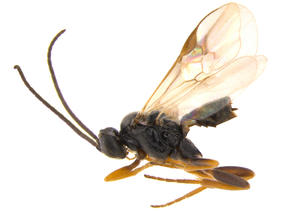You are here
Extant genera and species of Microgastrinae
Microgastrinae Förster 1862
Nomenclature
SUMMARY
Microgastrinae is a subfamily of Braconidae (Hymenoptera). It has been recognized as a distinct group for more than 150 years (Föerster, A. 1862. Synopsis der Familien und Gattungen der Braconen. Verhandlungen des Naturhistorischen Vereines preussischen Rheinlande und Westphalens 19: 225-288). Several morphological characteristics facilitate the recognition of Microgastrinae, among the most important and easy to see are:
1- Antenna with 16 flagellomeres (this was a universal character until the discovery in New Zealand of a new genus and species, Kiwigaster variabilis, which is unique among all microgastrines because its females have antenna with 18 flagellomeres and the males have 17).
2- Fore wing with basically no visible veins on apical third of the wing (see red rectangle on figure below).
3- First metasomal segment with strongly defined mediotergite without spiracles -spiracles are situated on separate laterotergites (see red arrow on figure below).
4- Metasoma (abdomen of other groups of insects) usually short, especially when compared with other groups of Braconidae (see figure below, which illustrates a "typical" Microgastrinae; but keep in mind that there are many exceptions to this general "body type").
Although Microgastrinae as a group is very easy to recognize and distinguish, their genera and species are notoriously difficult to tell apart and require years of study. In this website we will try to organize and present information that would hopefully help for that purpose.
Microgastrinae is a subfamily of Braconidae (Hymenoptera). It has been recognized as a distinct group for more than 150 years (Föerster, A. 1862. Synopsis der Familien und Gattungen der Braconen. Verhandlungen des Naturhistorischen Vereines preussischen Rheinlande und Westphalens 19: 225-288). Several morphological characteristics facilitate the recognition of Microgastrinae, among the most important and easy to see are:
1- Antenna with 16 flagellomeres (this was a universal character until the discovery in New Zealand of a new genus and species, Kiwigaster variabilis, which is unique among all microgastrines because its females have antenna with 18 flagellomeres and the males have 17).
2- Fore wing with basically no visible veins on apical third of the wing (see red rectangle on figure below).
3- First metasomal segment with strongly defined mediotergite without spiracles -spiracles are situated on separate laterotergites (see red arrow on figure below).
4- Metasoma (abdomen of other groups of insects) usually short, especially when compared with other groups of Braconidae (see figure below, which illustrates a "typical" Microgastrinae; but keep in mind that there are many exceptions to this general "body type").
Although Microgastrinae as a group is very easy to recognize and distinguish, their genera and species are notoriously difficult to tell apart and require years of study. In this website we will try to organize and present information that would hopefully help for that purpose.






